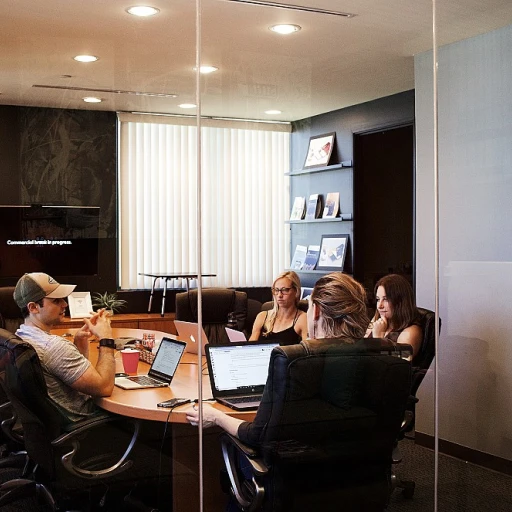Understanding the Importance of Office Privacy
Creating a Productive and Private Work Environment
In the hustle and bustle of an office, maintaining privacy and focus is often a significant challenge. As offices become increasingly open and collaborative, the demand for individual focus remains. Here lies the importance of implementing effective privacy measures to ensure that employees have the time and space they need to concentrate on their tasks.
An essential tool for enhancing office privacy is the 'Do Not Disturb' sign. These signs are not just mere paper articles that hang on a door. They are vital for signaling when an employee needs focused work time or uninterrupted space.
The concept of privacy in the workplace is fundamental to maintaining efficiency and productivity. When employees have the ability to control their environment through simple means such as a free printable 'Do Not Disturb' sign, the entire work atmosphere benefits. These signs allow team members to clearly communicate their need for a quiet background, whether they are working at their desk, in a meeting, or conducting testing sessions.
Moreover, having a do-not-disturb sign can prevent unnecessary interruptions, thus saving valuable time and reducing stress. An office environment that supports such practices exhibits a strong understanding of productivity balance, leading to enhanced focus and satisfaction among employees. To foster such an environment, it’s crucial to consider how the design and implementation of these signs can be optimized.
For additional insights on maintaining productivity and efficiency within your business, consider
enhancing business efficiency with change management tools.
Benefits of a Printable 'Do Not Disturb' Sign
Advantages of Using Printable "Do Not Disturb" Signs
In today's bustling office environments, maintaining focus and minimizing interruptions is crucial for productivity. Printable "Do Not Disturb" signs offer several benefits that make them an invaluable tool in promoting uninterrupted work.
- Cost-efficient Customization: Unlike permanent fixtures, these signs are easy on the budget. With free printable templates, offices can tailor the design to suit their specific needs without incurring extra costs.
- Flexibility and Convenience: A printed sign, made with a simple sheet of paper, can be displayed almost anywhere, from a door hanger to a wall notice. This flexibility ensures that employees can utilize the signs as needed, all while retaining the ability to easily replace or update them when the situation demands it.
- Engaging Designs: By opting for customizable printable designs, companies can visually align the signs with their brand or office aesthetic. From minimalist white backgrounds to colorful templates, the design choices are endless, fostering an environment that respects and acknowledges personal working preferences.
For more insights on how effective communication tools can optimize customer relations and supply chain efficiency, you can explore our guide
here.
The benefits extend beyond just enhancing privacy, as they also contribute significantly to team effectiveness. These printable signs help establish clear expectations, improving the company's workflow by allowing employees to focus during crucial work hours without the constant worry of unnecessary disturbances.
Designing an Effective 'Do Not Disturb' Sign
Elements to Design the Perfect 'Do Not Disturb' Sign
Designing an effective 'Do Not Disturb' sign involves more than just a simple "do not disturb" message on a piece of paper or a blank white background. A well-thought-out design can significantly enhance its effectiveness and readability.
Firstly, consider using clear and bold fonts for visibility from a distance. This ensures that anyone approaching can easily read the message, even in a busy or cluttered office environment. Incorporating elements such as contrasting colors between the text and the background can also help increase prominence and readability.
For those interested in a customizable option, utilizing a sign template available in PDF formats can offer flexibility. These printable disturb signs can be easily edited to fit specific office vibes or corporate branding. Take advantage of free printable options available online, as they provide a cost-effective way to implement changes as needed without compromising on design.
Incorporating elements of personalization can also be beneficial. This can include options to have a section on the sign for the office worker to indicate the expected duration of the disturbance, such as "on a call until 3 PM." Such adaptations offer a more tailored communication tool, allowing for greater understanding and cooperation among colleagues.
Consider the physical placement of the sign as part of its design, utilizing a door hanger or a door wall mount to improve visibility. The placement should ideally be at eye level, ensuring it catches the attention of people passing by.
Testing the design is as crucial as implementing it. After finalizing a template, conduct a brief testing period to observe how colleagues respond to the disturb signs. Gathering feedback can help refine the design and functionality.
Additionally, remember that these disturb signs can serve multiple environments outside an office, such as a hotel setting or during testing periods where privacy is required. Therefore, creating a versatile and adaptable design will ensure that the 'Do Not Disturb' message is clear and respected across various settings.
For a seamless transition into using customizable 'Do Not Disturb' signs, ensure you are
communicating an office move to your team effectively if any arrangements need to be altered concerning office dynamics.
Implementing the Sign in Your Office
Putting the Do Not Disturb Sign into Action
Implementing a Do Not Disturb sign effectively requires some thoughtful planning, ensuring it's both practical and respectful of everyone in the office. Here’s how you can seamlessly incorporate this tool into your workplace environment:
- Identify Key Areas: Determine which doors will benefit most from a Disturb Sign. Areas like conference rooms, private offices, and shared spaces during focused work sessions are common locations.
- Choose a Customizable Template: Utilize a printable template for your Do Not Disturb sign. There are many free templates available online in PDF or Word format, which you can customize with your company logo or specific messages.
- Design and Print: Select an appropriate design for your office environment. Keep it simple for readability, choosing a blank white background with bold text. Consider including a note detailing the estimated time of availability if applicable.
- Testing and Feedback: Conduct initial testing to gather feedback on the sign's effectiveness. Ensure it’s visible and that employees understand its use and purpose. Adjust the design if necessary.
- Communication and Training: Introduce the concept via an internal memo or meeting, ensuring all team members know how and when to use the Disturb Signs. Address any questions or concerns to avoid misunderstandings about the use or importance of these signs.
- Permanent Displays and Portability: For permanent spaces, consider mounting signs on walls or doors. Alternatively, use a door hanger format for portability, allowing easy relocation as needed.
Implementing a well-thought-out Do Not Disturb system is a proactive approach to minimizing interruptions and encouraging a focused work atmosphere. By taking each of these steps, you create a structured yet flexible framework for maximizing productivity.
Addressing Common Concerns and Misunderstandings
Clearing Up Common Misunderstandings
Creating a distraction-free workspace can sometimes lead to misunderstandings among employees. To ensure everyone is on the same page, it’s essential to address some common concerns about using a 'Do Not Disturb' sign in the office.
- Perceived Exclusion: One of the primary concerns is that the sign might create an environment of exclusion. To overcome this, communication is key. It should be clear that the sign is a tool to enhance productivity and not meant to alienate colleagues. Regularly remind employees through meetings or emails about the purpose behind using such a sign.
- Misinterpreting Availability: Employees may worry about misinterpretations regarding availability. Educate staff on the difference between essential interruptions and those that can wait. A simple briefing or instructional session can help bridge this gap.
- Ignorance or Forgetfulness: Sometimes, a 'Do Not Disturb' sign is simply overlooked or ignored. A consistent orientation about office protocols can help remind staff about respecting the 'Do Not Disturb' door sign. Regular reminders through digital channels can help keep the protocol fresh in people's minds.
- Over-reliance on Signs: There’s a concern that some may rely too heavily on these signs, using them excessively. It’s vital to monitor usage patterns and encourage a balanced approach—using the signs when truly necessary and fostering open communication at other times.
By proactively addressing these concerns, your custom designed 'Do Not Disturb' sign will be more effective in fostering a focused work environment. Consistent feedback and adjustments based on employee input can make the integration smoother, ensuring that printable templates and signs enhance office productivity."
}
Case Studies from UK Companies
Real World Applications of 'Do Not Disturb' Signs in UK Offices
In various office settings across the UK, the implementation of 'Do Not Disturb' signs has proven to be a game changer for enhancing focus and productivity. Offices in urban areas, surprisingly, have reported significant improvements in employee satisfaction and work output by adopting simple, adaptable signs that cater to varying needs.
One financial firm in London integrated a comprehensive disturb sign system, offering their employees free printable sign templates. By providing blank templates, employees could customize signs to fit the nature of their tasks. By doing so, the firm not only reduced workplace interruptions but also fostered an environment of respect for one another's concentration time.
Similarly, a marketing agency based in Manchester adopted printable disturb signs that could easily be attached to office doors. The key to their success was allowing team members to design their disturb door signs to naturally blend with the office décor, thereby keeping the workplace aesthetics intact.
Moreover, tech companies have harnessed PDF word templates, providing a versatile solution for employees working remotely. These digital templates can be displayed on computer screens during virtual meetings, effectively signaling a need for privacy even outside the traditional office setting.
There was initial hesitation regarding the blank door signs, primarily due to misunderstandings about their impact on team collaboration. However, through effective testing disturb frameworks, misunderstandings were alleviated. Employers encouraged feedback sessions, ensuring transparent communication that addressed concerns early.
The stand-out feature in both the financial and marketing sectors has been the adaptable template disturb options. By giving employees the autonomy to choose from a variety of disturb signs, productivity soared. Each sign, whether a hanging door or a paper door hanger, provides more than a simple "do not disturb" message; it empowers employees to take control over their concentration zones.
Integrating these signs into office life does more than protect individual working hours; it supports a culture where focused work is highly valued. Formal studies have not only validated the efficiency of signs in improving workflow but have also shed light on the simple yet profound impact they have on the overall office environment.

